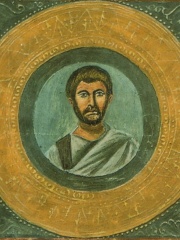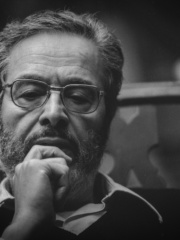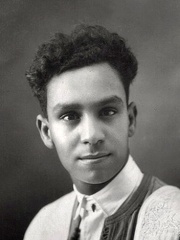






The Most Famous
WRITERS from Tunisia
Top 8
The following people are considered by Pantheon to be the most legendary Tunisian Writers of all time. This list of famous Tunisian Writers is sorted by HPI (Historical Popularity Index), a metric that aggregates information on a biography's online popularity.

1. Terence (185 BC - 159 BC)
With an HPI of 78.08, Terence is the most famous Tunisian Writer. His biography has been translated into 61 different languages on wikipedia.
Publius Terentius Afer (; c. 195/185 – c. 159 BC), better known in English as Terence (), was a playwright during the Roman Republic. He was the author of six comedies based on Greek originals by Menander or Apollodorus of Carystus. All six of Terence's plays survive complete and were originally produced between 166–160 BC. According to ancient authors, Terence was born in Carthage and was brought to Rome as a slave, where he gained an education and his freedom; around the age of 25, Terence is said to have made a voyage to the east in search of inspiration for his plays, where he died either of disease in Greece, or by shipwreck on the return voyage. However, Terence's traditional biography is often thought to consist of speculation by ancient scholars who lived too long after Terence to have access to reliable facts about his life. Terence's plays quickly became standard school texts. He ultimately secured a place as one of the four authors taught to all grammar pupils in the Western Roman Empire, and retained a central place in the European school curriculum until the 19th century, exercising a formative influence on authors such as William Shakespeare and Molière.

2. Avienus (305 - 375)
With an HPI of 68.35, Avienus is the 2nd most famous Tunisian Writer. His biography has been translated into 26 different languages.
Postumius Rufius Festus Avienius (or Avienus) was a Latin writer of the 4th century AD. He was a native of Volsinii in Etruria, from the distinguished family of the Rufii Festi. Avienius is not identical with the historian Festus.

3. Albert Memmi (1920 - 2020)
With an HPI of 62.83, Albert Memmi is the 3rd most famous Tunisian Writer. His biography has been translated into 26 different languages.
Albert Memmi (Arabic: ألبير ممّي; 15 December 1920 – 22 May 2020) was a French-Tunisian writer and essayist of Tunisian Jewish origins. A prominent intellectual, his nonfiction books and novels explored his complex identity as an anti-imperialist, deeply related to his ardent Zionism.

4. Nemesianus (300 - 300)
With an HPI of 60.91, Nemesianus is the 4th most famous Tunisian Writer. His biography has been translated into 19 different languages.
Marcus Aurelius Nemesianus was a Roman poet thought to have been a native of Carthage and flourished about AD 283. He was a popular poet at the court of the Roman emperor Carus (Historia Augusta, Carus, 11).

5. Gisèle Halimi (1927 - 2020)
With an HPI of 60.45, Gisèle Halimi is the 5th most famous Tunisian Writer. Her biography has been translated into 23 different languages.
Gisèle Halimi (born Zeiza Gisèle Élise Taïeb, Arabic: زايزا جيزيل إليز طيب; 27 July 1927 – 28 July 2020) was a Tunisian-French lawyer, politician, essayist and feminist activist.

6. Dracontius (455 - 505)
With an HPI of 60.42, Dracontius is the 6th most famous Tunisian Writer. His biography has been translated into 17 different languages.
Blossius Aemilius Dracontius (c. 455 – c. 505 AD) of Carthage was a Christian poet who flourished in Roman Africa during the latter part of the 5th century. He belonged to a family of landowners, and practiced as a lawyer in his native place. After the conquest of the country by the Vandals, Dracontius was at first allowed to retain possession of his estates, but was subsequently despoiled of his property and thrown into prison by the Vandal king Gaiseric, whose triumphs he had omitted to celebrate, while he had written a panegyric on a foreign and hostile ruler. He subsequently addressed an elegiac poem to the king, asking pardon, and pleading for release. The result is not known, but it is supposed that Dracontius obtained his liberty and migrated to northern Roman Italy in search of peace and quiet. This is consistent with the discovery at Bobbio of a 15th-century MS., now in the Biblioteca Nazionale at Naples, containing a number of poems by Dracontius (the Carmina minora). The most important of his works is the De laudibus Dei in three books. The account of the creation, which occupies the greater part of the first book, was at an early date edited separately under the title of Hexameron, and it was not till 1791 that the three books were edited by Faustino Arévalo. The apology (Satisfactio) consists of 158 elegiac couplets; it is generally supposed that the king addressed is Gunthamund (484–496). The Carmina minora, nearly all in hexameter verse, consist of school exercises and rhetorical declamations, amongst others the fable of Hylas, with a preface to his tutor, the grammarian Felicianus; De raptu Helenae (The Rape of Helen); Medea; and two epithalamia. It is also probable that Dracontius was the author of the Orestis Tragoedia, a poem of some 1,000 hexameters, which in language, metre, and general treatment of the subject exhibits a striking resemblance to the other works of Dracontius. Opinions differ as to his poetical merits, but, when due allowance is made for rhetorical exaggeration and consequent want of lucidity, his works show considerable vigour of expression, and a remarkable knowledge of the Bible and of Roman classical literature.

7. Aboul-Qacem Echebbi (1909 - 1934)
With an HPI of 58.26, Aboul-Qacem Echebbi is the 7th most famous Tunisian Writer. His biography has been translated into 15 different languages.
Aboul-Qacem Echebbi (Arabic: أبو القاسم الشابي, ALA-LC: Abū al-Qāsim al-Shābbī; (24 February 1909 – 9 October 1934) was a Tunisian poet. He is probably best known for writing the final two verses of the current national anthem of Tunisia, Humat al-Hima (Defenders of the Homeland), which was originally written by the Egyptian poet Mustafa Sadik el-Rafii.

8. Ahlam Mosteghanemi (b. 1953)
With an HPI of 56.34, Ahlam Mosteghanemi is the 8th most famous Tunisian Writer. Her biography has been translated into 24 different languages.
Ahlam Mosteghanemi (Arabic: أحلام مستغانمي; born 13 April 1953, Tunisia) is an Algerian poet and writer. She was the first Algerian woman to write poetry and fiction in Arabic. She has published four novels and six anthologies, and is best known for her 1993 novel Memory of the Flesh. In 2007 and 2008, she was ranked #96 and #58 respectively as the most influential Arab by the Arabian Business magazine.
People
Pantheon has 8 people classified as Tunisian writers born between 185 BC and 1953. Of these 8, 1 (12.50%) of them are still alive today. The most famous living Tunisian writers include Ahlam Mosteghanemi. The most famous deceased Tunisian writers include Terence, Avienus, and Albert Memmi.
Living Tunisian Writers
Go to all RankingsDeceased Tunisian Writers
Go to all RankingsTerence
185 BC - 159 BC
HPI: 78.08
Avienus
305 - 375
HPI: 68.35
Albert Memmi
1920 - 2020
HPI: 62.83
Nemesianus
300 - 300
HPI: 60.91
Gisèle Halimi
1927 - 2020
HPI: 60.45
Dracontius
455 - 505
HPI: 60.42
Aboul-Qacem Echebbi
1909 - 1934
HPI: 58.26
Overlapping Lives
Which Writers were alive at the same time? This visualization shows the lifespans of the 3 most globally memorable Writers since 1700.

